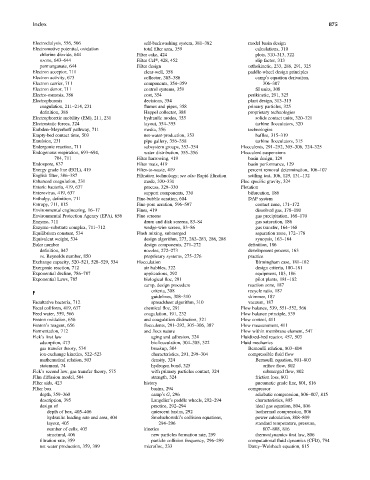Page 920 - Fundamentals of Water Treatment Unit Processes : Physical, Chemical, and Biological
P. 920
Index 875
Electrodialysis, 556, 566 self-backwashing system, 381–382 model basin design
Electromotive potential, oxidation total filter area, 359 calculations, 310
chlorine dioxide, 644 Filter cake, 424 plots, 310–313, 322
ozone, 643–644 Filter Celt, 428, 452 slip factor, 313
permanganate, 644 Filter design orthokinetic, 233, 286, 291, 325
Electron acceptor, 711 clear-well, 358 paddle-wheel design principles
Electron activity, 673 collector, 385–386 camp’s equation derivation,
Electron carrier, 711 components, 354–359 306–307
Electron donor, 711 control systems, 359 SI units, 308
Electro-osmosis, 386 cost, 354 perikinetic, 291, 325
Electrophoresis decisions, 354 plant design, 313–315
coagulation, 211–214, 231 flumes and pipes, 358 primary particles, 325
definition, 386 Happel collector, 388 proprietary technologies
Electrophoretic mobility (EM), 211, 231 hydraulic modes, 355 solids contact units, 320–321
Electrostatic forces, 324 layout, 354–355 turbine flocculators, 320
Embden–Meyerhoff pathway, 711 media, 356 technologies
Empty-bed contact time, 503 net-water-production, 353 baffles, 315–319
Emulsion, 231 pipe gallery, 356–358 turbine flocculators, 315
Endergonic reaction, 711 subsystem groups, 353–354 Flocculents, 291–292, 305–306, 324–325
Endogenous respiration, 693–694, water distribution, 355–356 Flocculent suspensions
704, 711 Filter harrowing, 419 basin design, 129
Endospore, 637 Filter mats, 419 basin performance, 129
Energy grade line (EGL), 419 Filter-to-waste, 419 percent removal determination, 106–107
English filter, 386–387 Filtration technology; see also Rapid filtration settling test, 106, 129, 131–132
Enhanced coagulation, 231 mode, 330–331 Floc specific gravity, 324
Enteric bacteria, 419, 637 process, 329–330 Flotation
Enterovirus, 419, 637 support components, 330 bifurcation, 186
Enthalpy, definition, 711 Fine-bubble aeration, 604 DAF system
Entropy, 711, 815 Fine-pore aeration, 596–597 contact zone, 171–172
Environmental engineering, 16–17 Fines, 419 dissolved gas, 178–180
Environmental Protection Agency (EPA), 656 Fine screens gas precipitation, 168–170
Enzyme, 711 drum and disk screens, 83–84 gas saturation, 186
Enzyme–substrate complex, 711–712 wedge-wire screen, 83–86 gas transfer, 164–168
Equilibrium constant, 534 Flash mixing, submerged separation zone, 172–178
Equivalent weight, 534 design algorithm, 273, 282–283, 286, 288 synopsis, 163–164
Euler number design components, 271–272 definition, 186
definition, 847 nozzles, 272–273 development process, 163
vs. Reynolds number, 850 proprietary systems, 275–276 practice
Exchange capacity, 520–521, 528–529, 534 Flocculation Birmingham case, 181–182
Exergonic reaction, 712 air bubbles, 322 design criteria, 180–181
Exponential decline, 786–787 applications, 292 equipment, 183, 186
Exponential Laws, 785 biological floc, 291 pilot plants, 181–182
camp, design procedure reaction zone, 187
F criteria, 308 recycle ratio, 187
guidelines, 308–310 skimmer, 187
Facultative bacteria, 712 spreadsheet algorithm, 310 vacuum, 187
Fecal coliform, 419, 637 chemical floc, 291 Flow balance, 539, 551–552, 566
Feed water, 559, 566 coagulation, 191, 232 Flow balance principle, 539
Fenton oxidation, 656 and coagulation distinction, 321 Flow control, 411
Fenton’s reagent, 656 flocculents, 291–292, 305–306, 387 Flow measurement, 411
Fermentation, 712 and flocs nature Flow within membrane element, 547
Fick’s first law aging and adhesion, 324 Fluidized-bed reactor, 457, 503
adsorption, 473 bioflocculation, 304–305, 322 Fluid mechanics
gas transfer theory, 574 breakup, 304 Bernoulli relation, 803–804
ion-exchange kinetics, 522–523 characteristics, 291, 299–304 compressible fluid flow
mathematical relation, 503 density, 324 Bernoulli equation, 801–803
statement, 74 hydrogen bond, 325 orifice flow, 802
Fick’s second law, gas transfer theory, 575 with primary particles contact, 324 submerged flow, 802
Film diffusion model, 504 strength, 324 friction loss, 801
Filter aids, 423 history pneumatic grade line, 801, 816
Filter box basins, 294 compressor
depth, 359–360 camp’s G, 296 adiabatic compression, 806–807, 815
description, 395 Langelier’s paddle wheels, 292–294 characteristics, 805
design of practice, 292–294 ideal gas equation, 804, 806
depth of box, 405–406 quiescent basins, 292 isothermal compression, 806
hydraulic loading rate and area, 404 Smoluchowski’s collision equations, power calculation, 808–809
layout, 405 294–296 standard temperature, pressure,
number of cells, 405 kinetics 807–808, 816
structural, 406 new particles formation rate, 299 thermodynamics first law, 806
filtration rate, 359 particle collision frequency, 296–299 computational fluid dynamics (CFD), 794
net water production, 359, 389 microfloc, 233 Darcy–Weisbach equation, 815

